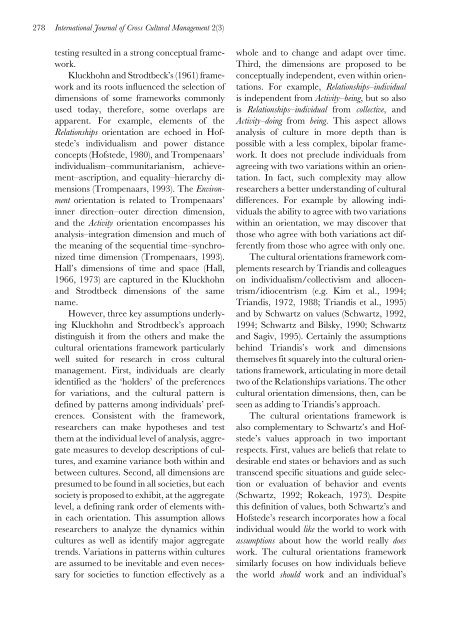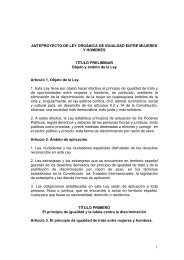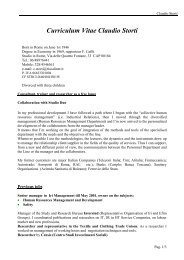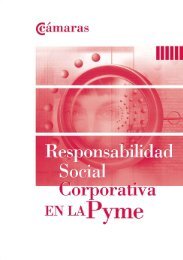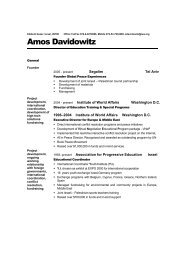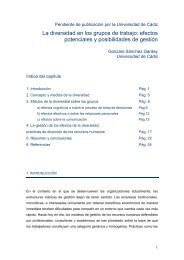Cultural dimensions - IMD
Cultural dimensions - IMD
Cultural dimensions - IMD
You also want an ePaper? Increase the reach of your titles
YUMPU automatically turns print PDFs into web optimized ePapers that Google loves.
278International Journal of Cross <strong>Cultural</strong> Management 2(3)testing resulted in a strong conceptual framework.Kluckhohn and Strodtbeck’s (1961) frameworkand its roots influenced the selection of<strong>dimensions</strong> of some frameworks commonlyused today, therefore, some overlaps areapparent. For example, elements of theRelationships orientation are echoed in Hofstede’sindividualism and power distanceconcepts (Hofstede, 1980), and Trompenaars’individualism–communitarianism, achievement–ascription,and equality–hierarchy <strong>dimensions</strong>(Trompenaars, 1993). The Environmentorientation is related to Trompenaars’inner direction–outer direction dimension,and the Activity orientation encompasses hisanalysis–integration dimension and much ofthe meaning of the sequential time–synchronizedtime dimension (Trompenaars, 1993).Hall’s <strong>dimensions</strong> of time and space (Hall,1966, 1973) are captured in the Kluckhohnand Strodtbeck <strong>dimensions</strong> of the samename.However, three key assumptions underlyingKluckhohn and Strodtbeck’s approachdistinguish it from the others and make thecultural orientations framework particularlywell suited for research in cross culturalmanagement. First, individuals are clearlyidentified as the ‘holders’ of the preferencesfor variations, and the cultural pattern isdefined by patterns among individuals’ preferences.Consistent with the framework,researchers can make hypotheses and testthem at the individual level of analysis, aggregatemeasures to develop descriptions of cultures,and examine variance both within andbetween cultures. Second, all <strong>dimensions</strong> arepresumed to be found in all societies, but eachsociety is proposed to exhibit, at the aggregatelevel, a defining rank order of elements withineach orientation. This assumption allowsresearchers to analyze the dynamics withincultures as well as identify major aggregatetrends. Variations in patterns within culturesare assumed to be inevitable and even necessaryfor societies to function effectively as awhole and to change and adapt over time.Third, the <strong>dimensions</strong> are proposed to beconceptually independent, even within orientations.For example, Relationships–individualis independent from Activity–being, but so alsois Relationships–individual from collective, andActivity–doing from being. This aspect allowsanalysis of culture in more depth than ispossible with a less complex, bipolar framework.It does not preclude individuals fromagreeing with two variations within an orientation.In fact, such complexity may allowresearchers a better understanding of culturaldifferences. For example by allowing individualsthe ability to agree with two variationswithin an orientation, we may discover thatthose who agree with both variations act differentlyfrom those who agree with only one.The cultural orientations framework complementsresearch by Triandis and colleagueson individualism/collectivism and allocentrism/idiocentrism(e.g. Kim et al., 1994;Triandis, 1972, 1988; Triandis et al., 1995)and by Schwartz on values (Schwartz, 1992,1994; Schwartz and Bilsky, 1990; Schwartzand Sagiv, 1995). Certainly the assumptionsbehind Triandis’s work and <strong>dimensions</strong>themselves fit squarely into the cultural orientationsframework, articulating in more detailtwo of the Relationships variations. The othercultural orientation <strong>dimensions</strong>, then, can beseen as adding to Triandis’s approach.The cultural orientations framework isalso complementary to Schwartz’s and Hofstede’svalues approach in two importantrespects. First, values are beliefs that relate todesirable end states or behaviors and as suchtranscend specific situations and guide selectionor evaluation of behavior and events(Schwartz, 1992; Rokeach, 1973). Despitethis definition of values, both Schwartz’s andHofstede’s research incorporates how a focalindividual would like the world to work withassumptions about how the world really doeswork. The cultural orientations frameworksimilarly focuses on how individuals believethe world should work and an individual’s


